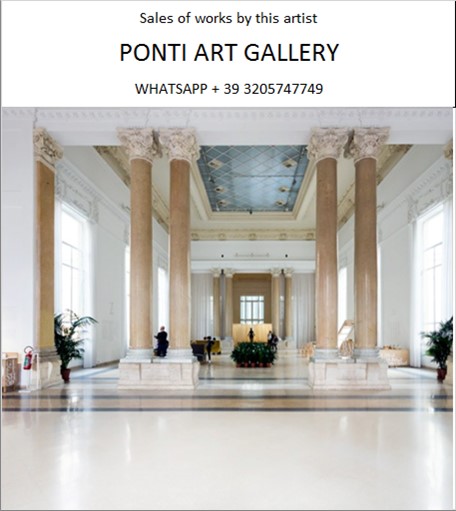Ponti Art Gallery is interested in buying and selling works
of art by this artist.

Fortunato Depero Biography
Fortunato Depero was an Italian artist whose multifaceted work spanned painting, sculpture, graphic design, and theater, making him one of the most dynamic and influential figures of the Futurist movement. Born on March 30, 1892, in Fondo, Trentino, which was then part of the Austro-Hungarian Empire, Depero grew up in Rovereto, a town that would remain significant throughout his life.
Depero's artistic journey began at the Scuola Reale Elisabettina in Rovereto, where he was exposed to technical specialization and applied arts, a hallmark of Austrian education at the time. His early career saw him apprenticing as a marble worker, which ignited his love for sculpture and three-dimensional forms. This formative period was crucial in shaping his artistic sensibilities, which would later be characterized by a bold, geometric style.
The turning point in Depero's career came in 1913 during a trip to Florence, where he encountered the Italian literary journal Lacerba, closely linked to Futurism. This discovery propelled him to Rome, where he met key figures of the Italian Futurism movement, including Giacomo Balla, with whom he would later co-author the manifesto "Ricostruzione Futurista dell’universo" (Futurist Reconstruction of the Universe) in 1915. This manifesto called for a radical reimagining of the universe by integrating art into everyday life, thus making the world a more joyful place.
Depero's work in the following years was marked by a pioneering spirit that saw him delve into various creative ventures. He founded the "Casa d'Arte Futurista" in Rovereto in 1919, a workshop that produced toys, tapestries, and furniture in the Futurist style. His wife, Rosetta Amadori, played a crucial role in his artistic development, particularly in the realm of textile art, which became a significant part of his oeuvre.
In the 1920s, Depero's work expanded to include advertising, where he designed posters and campaigns for brands like Campari, and worked on ballets, such as "Anihccam del 3000." His success in this field led him to New York in 1928, where he continued to work in theater and advertising, creating covers for magazines like The New Yorker and Vogue. Despite his achievements, the economic downturn following the Wall Street crash made his stay in New York challenging, and he returned to Italy in 1930.
Back in Italy, Depero continued to innovate, engaging with the promotion of new materials like buxus for furniture and object design. He published his autobiography in 1940, which provided insights into his life and works. During World War II, Depero faced accusations of fascism, which he later claimed were solely for economic survival. After the war, he retreated to the alpine village of Serrada with his wife.
In the post-war years, Depero struggled with health issues and the changing political landscape. Despite these challenges, he remained dedicated to his vision of Futurism and worked tirelessly to establish the first Futurist museum, the "Galleria Museo Depero," which opened in 1959 in Rovereto. Unfortunately, Depero's health prevented him from attending the opening ceremony, and he passed away on November 29, 1960.
Depero's legacy is one of relentless creativity and innovation. His work across various mediums and his commitment to the Futurist ethos of integrating art into all aspects of life have left an indelible mark on the history of modern art. His contributions to the fields of graphic design, advertising, and theater design continue to be celebrated, and his influence can be seen in the works of many artists and designers who followed. The "Galleria Museo Depero" stands as a testament to his life's work, housing an extensive collection of his creations and manuscripts, ensuring that his groundbreaking contributions to art and design are remembered and appreciated by future generations.
Fortunato Depero Quotes and
Sales of Works
Ponti Art Gallery selects and deals with paintings by the
artist. Upon request, we provide free estimates and
evaluations, communicate prices, quotations, and current
market values.
If you are interested in BUYING or SELLING works by the
artist, contact us immediately.
If you wish to sell or receive an evaluation of the
works:
Send us a frontal photo of the painting, one of the back,
and one of the signature. Also, indicate the dimensions of
the work. Inform us about the purchase origin of the work
and any kind of available documentation (purchase
receipts, certificates of authenticity, publications). One
of our operators will respond to you on the same day. We
guarantee maximum confidentiality and extreme
professionalism.
If you wish to purchase works by the painter: Contact us
and let us know your request. We will inform you about the
available works. We also offer the possibility to
subscribe to our NEWSLETTER, through which you will be
informed at the beginning of each month about the latest
acquisitions of the art gallery.
You can send us pictures of the work:
